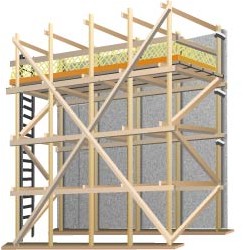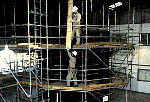|
|
Pole or Wood Pole
 Pole
scaffolds are a type of supported scaffold in which every structural component, from uprights to braces to platforms, is
made of wood. OSHA has standards for two kinds: single-pole, which are supported on their interior side by a structure
or wall, and double-pole, which are supported by double uprights independent of any structure. Pole
scaffolds are a type of supported scaffold in which every structural component, from uprights to braces to platforms, is
made of wood. OSHA has standards for two kinds: single-pole, which are supported on their interior side by a structure
or wall, and double-pole, which are supported by double uprights independent of any structure.
Because they have to be built from scratch and cannot easily be reused, pole scaffolds are considered old-fashioned and
are rarely used today. Note: The requirements on this page are specific to pole scaffolds
only. For requirements that apply to all types of supported scaffolds, please refer to the Frame or Fabricated module of
this eTool.
| << General
Requirements |
- When platforms are moved to the next level, the existing platform must be left undisturbed
until the new bearers have been set in place and braced. [1926.452(a)(1)]
- Where wooden poles are spliced, the following regulations apply:
- The ends must be squared;
- The upper section must rest squarely on the lower section;
- Wood splice plates or scab plates must be provided on at least two adjacent sides, and must:
- Extend at least 2 feet on either side of the splice,
- Overlap the abutted ends equally, and
- Have at least the same cross-sectional areas as the pole;
- Splice plates made of materials other than wood may be used, as long as they are of equivalent
strength. [1926.452(a)(9)]
- Pole scaffolds over 60 feet in height must:
- Be designed by a registered professional engineer, and
- Be constructed and loaded in accordance with that design. [1926.452(a)(10)]
Note: Non-mandatory Appendix A to this subpart contains examples of criteria that will enable an
employer to comply with design and loading requirements for pole scaffolds under 60 feet in height.
|
| << Braces,
Bearers and Runners |
- Crossbracing must be installed between the inner and outer sets of
poles on double pole scaffolds. [1926.452(a)(2)]
- Diagonal bracing must be installed in both directions
across:
- The entire outside face of double- and single-pole scaffolds [1926.452(a)(4)],
and
- The entire inside face of double-pole scaffolds used to support loads of 50 lbs. or
more per square foot. [1926.452(a)(3)]
- Runners and bearers must be installed on edge. [1926.452(a)(5)]
- Bearers must extend a minimum of 3 inches over the outside edge
of runners. [1926.452(a)(6)]
- Runners must:
- Extend over two poles at minimum, and
- Be supported by bearing blocks securely attached to the poles. [1926.452(a)(7)]
- Braces, bearers, and runners must not be spliced between poles.
[1926.452(a)(8)]
|
| << Non-mandatory
Guidelines |
Single Pole Wood Pole Scaffolds
1926
Subpart L Appendix A(2)(a)
| |
Light Duty
up to
20 feet High |
Light Duty
up to
60 feet High |
Medium Duty
up to
60 feet High |
Heavy Duty
up to
60 feet High |
| Maximum Intended Load |
25 pounds/foot² |
25 pounds/foot² |
50 pounds/foot² |
75 pounds/foot² |
| Poles or uprights |
2 x 4 inches |
4 x 4 inches |
4 x 4 inches |
4 x 6 inches |
| Maximum pole spacing (longitudinal) |
6 feet |
10 feet |
8 feet |
6 feet |
| Maximum pole spacing (transverse) |
5 feet |
5 feet |
5 feet |
5 feet |
| Runners |
1 x 4 inches |
1¼ x 9 inches |
2 x 10 inches |
2 x 10 inches |
| Bearers and maximum spacing of bearers: |
|
| 3 feet |
2 x 4 inches |
2 x 4 inches |
2 x 10 inches
or
3 x 4 inches |
2 x 10 inches
or
3 x 5 inches |
| 5 feet |
2 x 6 inches
or
3 x 4 inches |
2 x 6 inches
or
3 x 4 inches (rough) |
2 x 10 inches
or
3 x 4 inches |
2 x 10 inches
or
3 x 5 inches |
| 6 feet |
— |
— |
2 x 10 inches
or
3 x 4 inches |
2 x 10 inches
or
3 x 5 inches |
| 8 feet |
— |
— |
2 x 10 inches
or
3 x 4 inches |
— |
| Planking |
1¼ x 9 inches |
2 x 10 inches |
2 x 10 inches |
2 x 10 inches |
| Maximum vertical spacing of horizontal members |
7 feet |
9 feet |
7 feet |
6 feet 6 inches |
| Bracing (horizontal) |
1 x 4 inches |
1 x 4 inches |
1 x 6 inches
or
1¼ x 4 inches |
2 x 4 inches |
| Bracing (diagonal) |
1 x 4 inches |
1 x 4 inches |
1 x 4 inches |
2 x 4 inches |
| Tie-ins |
1 x 4 inches |
1 x 4 inches |
1 x 4 inches |
1 x 4 inches |
Independent Wood Pole Scaffold
1926
Subpart L Appendix A(2)(a)
| |
Light Duty
up to
20 feet High |
Light Duty
up to
60 feet High |
Medium Duty
up to
60 feet High |
Heavy Duty
up to
60 feet High |
| Maximum intended load |
25 pounds/foot² |
25 pounds/foot² |
50 pounds/foot² |
75 pounds/foot² |
| Poles or uprights |
2 x 4 inches |
4 x 4 inches |
4 x 4 inches |
4 x 4 inches |
| Maximum pole spacing (longitudinal) |
6 feet |
10 feet |
8 feet |
6 feet |
| Maximum pole spacing (transverse) |
5 feet |
5 feet |
5 feet |
5 feet |
| Runners |
1¼ x 4 inches |
1¼ x 9 inches |
2 x 10 inches |
2 x 10 inches |
| Bearers and maximum spacing of bearers: |
|
| 3 feet |
2 x 4 inches |
2 x 4 inches |
2 x 10 inches |
2 x 10 inches
(rough) |
| 6 feet |
2 x 6 inches
or
3 x 4 inches |
2 x 10 inches (rough) or
3 x 8 inches |
2 x 10 inches |
2 x 10 inches (rough) |
| 8 feet |
2 x 6 inches
or
3 x 4 inches |
2 x 10 inches (rough) or
3 x 8 inches |
2 x 10 inches |
— |
| 10 feet |
2 x 6 inches
or
3 x 4 inches |
2 x 10 inches
(rough) or
3 x 3 inches |
— |
— |
| Planking |
1¼ x 9 inches |
2 x 10 inches |
2 x 10 inches |
2 x 10 inches |
| Maximum vertical spacing of horizontal members |
7 feet |
7 feet |
6 feet |
6 feet |
| Bracing (horizontal) |
1 x 4 inches |
1 x 4 inches |
1 x 6 inches
or
1¼ x 4 inches |
2 x 4 inches |
| Bracing (diagonal) |
1 x 4 inches |
1 x 4 inches |
1 x 4 inches |
2 x 4 inches |
| Tie-ins |
1 x 4 inches |
1 x 4 inches |
1 x 4 inches |
1 x 4 inches |
|
|


 Pole
scaffolds are a type of supported scaffold in which every structural component, from uprights to braces to platforms, is
made of wood. OSHA has standards for two kinds: single-pole, which are supported on their interior side by a structure
or wall, and double-pole, which are supported by double uprights independent of any structure.
Pole
scaffolds are a type of supported scaffold in which every structural component, from uprights to braces to platforms, is
made of wood. OSHA has standards for two kinds: single-pole, which are supported on their interior side by a structure
or wall, and double-pole, which are supported by double uprights independent of any structure.